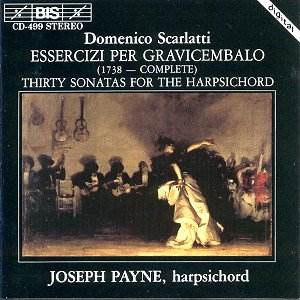 |
Domenico SCARLATTI (1685-1757) Crotchet
AmazonUK
AmazonUS |
Domenico Scarlatti, who was roughly a contemporary of Bach and Haendel, was born in Naples, and, around age 35, moved to Portugal, where he went to teach harpsichord to Princess Maria Barbara. When she married the future king of Spain in 1729, he went with her to Spain, where he lived the rest of his life. While he may have written some of his 555 harpsichord sonatas in Italy, it is likely that most of them were written in this later part of his life. The son of the famous composer Alessandro Scarlatti, his church music, written during the first part of his life, is largely unmemorable. But, something happened to Domenico when he left his native Italy - perhaps it was because he was no longer in the shadow of his father, but he went on to compose one of the greatest monuments of keyboard music in the world.
For those unfamiliar with Scarlatti's monumental oeuvre of harpsichord sonatas, the very first bars of this disc give an excellent idea of the type of music he composed. The quirky energy in the first sonata is very typical of his writing - his sonatas are all short and most are rapid, with expressive phrases that dance across the keyboard in an energetic display of virtuosity. Unfortunately, these works are often played on piano, where they lose the incisive sound that can only come from the harpsichord. Playing them on the piano means that the longer sounding notes merge into a confusing mass; few pianists can do justice to these works.
While some have compared this set of pieces, the only sonatas published during Scarlatti's lifetime, with Bach's Goldberg Variations, saying the latter may have been based on Scarlatti's works (partly because of the number of variations - 30), listening to them shows that this is not the case. Scarlatti's Essercizi are not variations; this set can be seen more as a collection of varied pieces, with no tonal nor thematic relationship.
The main thread that holds these works together is their energy. All but two of the pieces are marked allegro or presto; the two remaining pieces include one that is unmarked (sonata XI, a short work in C minor, that is slightly slower than most of the others, in which the melody is more central than the rhythm), and the final sonata, number XXX, which is a fugue, marked moderato. This is a brilliant fugue, based on a very simple, ascending subject, that reaches a fitting apotheosis to close out this set.
Yet Scarlatti was not a writer of fugues; of his 555 sonatas, only a small number are fugues. As John Gillespie says, in his book, Five Centuries of Keyboard Music, "If Scarlatti's music does not strive for profundity, it forever has its elegance. A relentless searcher for brilliant and unusual effects, Scarlatti avoids triviality and aims for an expressive, sometimes dramatic line." There are few ornaments in these works, and Scarlatti instead uses brilliantly fast runs along the keyboard to embellish his pieces. He was a master of applying rhythm to his sonatas, as can be heard in sonata XIII, with its simple melody containing many repeated notes, giving it a catchy rhythm, or what Joseph Payne calls, "infectiously cheerful chatter".
Payne performs these works very well. He is right at home with the rhythm and energy of these pieces, and, as in all his recordings for Bis, plays a beautifully-sounding instrument. This recording is highly recommended as an introduction to Scarlatti's works, yet, for those who wish to discover the full range of his works, Scott Ross's masterful recording of all 555 sonatas is the only choice.
Kirk McElhearn